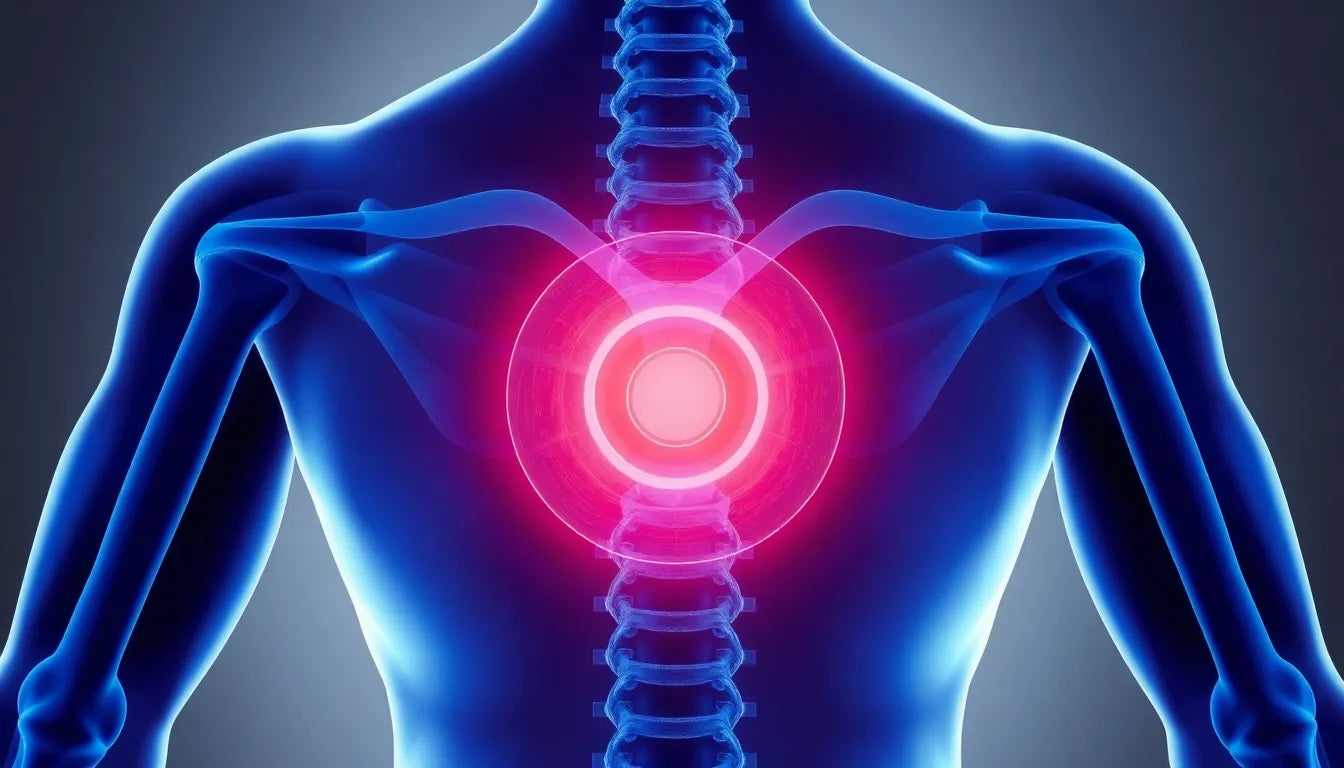Herniated discs are a common ailment affecting many individuals, leading to painful flare-ups that can significantly impact daily life. Understanding the timeline of these flare-ups is crucial for effective pain management and setting realistic recovery expectations. This knowledge not only empowers individuals to manage their symptoms better but also provides insight into the healing process, allowing for a more proactive approach to health and wellness.
what is a herniated disc?
A herniated disc occurs when the soft inner core of a spinal disc protrudes through its tougher outer layer, often resulting in intense pain and limited mobility. This condition can lead to flare-ups, where symptoms suddenly worsen, causing discomfort and hindering normal activities. These flare-ups can vary greatly in duration and intensity, making it essential to understand the factors that influence their timeline.
understanding flare-up variability
The duration of herniated disc flare-ups can range from a few days to several weeks, with some cases extending up to six months for complete recovery. The variability in flare-up duration is influenced by several factors, including the severity of the herniation, the individual's overall health, and the treatment approach. Recognizing these factors can help individuals tailor their recovery strategies, ensuring a more efficient healing process.
For those experiencing herniated disc flare-ups, knowing the typical stages of recovery can provide a roadmap for what to expect. Initially, the acute inflammation stage is marked by intense pain and discomfort, often lasting from one to two weeks. This is followed by a gradual improvement stage, where pain begins to decrease, and mobility improves. Understanding these stages can aid in managing expectations and planning appropriate interventions to support healing.
By gaining a comprehensive understanding of herniated disc flare-ups and their timelines, individuals can take proactive steps to manage their condition effectively. This involves not only addressing immediate pain relief but also implementing long-term strategies to prevent future flare-ups. Through a combination of medical guidance, lifestyle adjustments, and a thorough understanding of the condition, it is possible to navigate the challenges of herniated disc flare-ups with greater confidence and control.
duration of herniated disc flare-ups: what to expect
Understanding the typical timeline of herniated disc flare-ups is crucial for managing expectations and planning recovery strategies. Generally, the duration of these flare-ups can vary, but most individuals experience relief within a few days to several weeks. In some cases, however, the healing process can extend up to six months, depending on various factors.
acute inflammation stage (1-2 days to 2 weeks)
The initial phase of a herniated disc flare-up is the acute inflammation stage, characterized by intense pain and discomfort. This stage typically lasts from one to two days up to two weeks. During this period, individuals may experience sharp lower back pain, radiating sciatica, muscle spasms, and numbness. These symptoms are often at their peak, making this stage particularly challenging.
gradual improvement stage (2-6 weeks)
Following the acute inflammation stage, the gradual improvement stage begins. This phase lasts approximately two to six weeks and is marked by a noticeable decrease in pain and an increase in mobility. Individuals often find that pain episodes become less frequent, and muscle spasms reduce in intensity. This stage is crucial for regaining function and starting to resume daily activities.
plateau and stabilization stage (6-12 weeks)
As recovery progresses, individuals enter the plateau and stabilization stage, typically occurring between six and twelve weeks. During this time, significant pain improvement is observed, although occasional flare-ups may still occur. This stage is essential for stabilizing the condition and preparing for a return to normal activities. Most people experience a marked reduction in symptoms, allowing for a more active lifestyle.
long-term management (beyond 12 weeks)
Beyond twelve weeks, the focus shifts to long-term management of the condition. At this point, most individuals can resume their normal activities, but it remains important to implement strategies to prevent future flare-ups. This involves maintaining a healthy lifestyle, engaging in regular exercise, and practicing good posture and body mechanics. Long-term management is essential for sustaining recovery and minimizing the risk of recurrence.
factors affecting recovery time
The duration of herniated disc flare-ups can vary significantly based on several key factors. Understanding these factors can help individuals tailor their recovery approaches to achieve optimal results.
severity of the herniation
The severity of the herniation plays a critical role in determining recovery time. Mild herniations may cause minor symptoms that are manageable with rest and over-the-counter medications. In contrast, severe herniations can result in more intense and prolonged symptoms, requiring extensive treatment and a longer recovery period.
patient's health status
An individual's overall health status, including physical fitness, age, and activity level, can significantly impact the healing process. Those in good physical shape often experience faster recovery times, as their bodies are better equipped to manage and heal from the condition. Conversely, individuals with underlying health issues or sedentary lifestyles may face longer recovery periods.
treatment approach
The choice of treatment approach is another crucial factor influencing recovery time. Early and comprehensive treatment, including consistent physical therapy, can lead to faster and more effective healing. Engaging in a well-structured rehabilitation program can help strengthen the muscles supporting the spine, reduce pain, and improve mobility, ultimately shortening the duration of flare-ups.
In conclusion, understanding the timeline and factors affecting herniated disc flare-ups is essential for effective management and recovery. By recognizing the stages of healing and the variables that influence recovery, individuals can take proactive steps to manage their condition and minimize the impact of future flare-ups. Consulting with healthcare professionals for personalized treatment plans is highly recommended to ensure the best possible outcomes.
effective treatment recommendations for herniated disc flare-ups
Managing herniated disc flare-ups effectively involves a combination of immediate relief measures and strategies to promote long-term recovery. By understanding these approaches, individuals can alleviate pain more efficiently and support the healing process.
immediate relief measures
During the initial stages of a herniated disc flare-up, it is crucial to focus on immediate pain relief. Applying ice packs to the affected area can help reduce inflammation and alleviate pain. Over-the-counter pain relief medications, such as ibuprofen or acetaminophen, can also be beneficial in managing discomfort. While rest is important, complete bed rest should be avoided. Instead, engage in light movement as tolerated, such as gentle walks or pool walking, to maintain some level of mobility without exacerbating symptoms.
promoting recovery
As the acute pain subsides, the focus should shift towards promoting recovery and preventing future flare-ups. Gentle motion exercises can help stimulate the stabilizing muscles around the spine, increasing blood flow to the injured area and supporting the healing process. Gradually returning to normal activities as comfort allows is essential, but it is important to avoid activities that could strain the back.
Incorporating regular physical therapy sessions can be highly beneficial in strengthening the muscles supporting the spine, improving posture, and enhancing overall mobility. A well-structured rehabilitation program tailored to the individual's needs can significantly contribute to a faster and more effective recovery.
conclusion
Understanding the timeline and factors affecting herniated disc flare-ups is vital for effective management and recovery. By recognizing the stages of healing and the variables that influence recovery, individuals can take proactive steps to manage their condition and minimize the impact of future flare-ups. Consulting with healthcare professionals for personalized treatment plans is highly recommended to ensure the best possible outcomes.
frequently asked questions
How long do herniated disc flare-ups typically last?
Most herniated disc flare-ups last from a few days to several weeks, but in some cases, they can extend up to six months for complete healing.
What are the common symptoms during a flare-up?
Common symptoms during a herniated disc flare-up include intense pain, sciatica, muscle spasms, numbness, and reduced mobility.
Can lifestyle changes help in managing flare-ups?
Yes, lifestyle changes such as maintaining good posture, engaging in regular exercise, and avoiding heavy lifting can help manage flare-ups and prevent future occurrences.
When should I seek medical attention for a herniated disc?
You should seek medical attention if the pain persists beyond a few weeks or if there are signs of nerve damage, such as weakness or loss of bladder control.
Is surgery necessary for herniated disc flare-ups?
Surgery is generally considered when conservative treatments fail or if there are severe symptoms, such as nerve damage. It is important to consult with a healthcare professional to determine the best course of action.
Sources
- Barricaid's Blog. "How Long Do Herniated Disc Flare-Ups Last?"
- MoreGoodDays. "Managing a Herniated Disc Flare-up."
- Spine MD. "Signs a Herniated Disc is Healing: Timeline & Recovery."
- ADR Spine. "How Long Does a Herniated Disc Take to Heal?"
- HealthCentral. "Herniated Disc Healing: Timeline and Signs of Improvement."
- OWC Health. "Herniated Disc Sciatica Recovery Time: What to Expect."


















